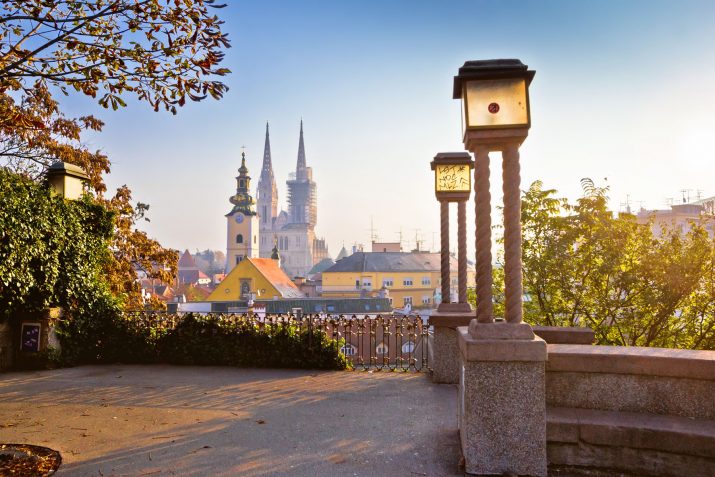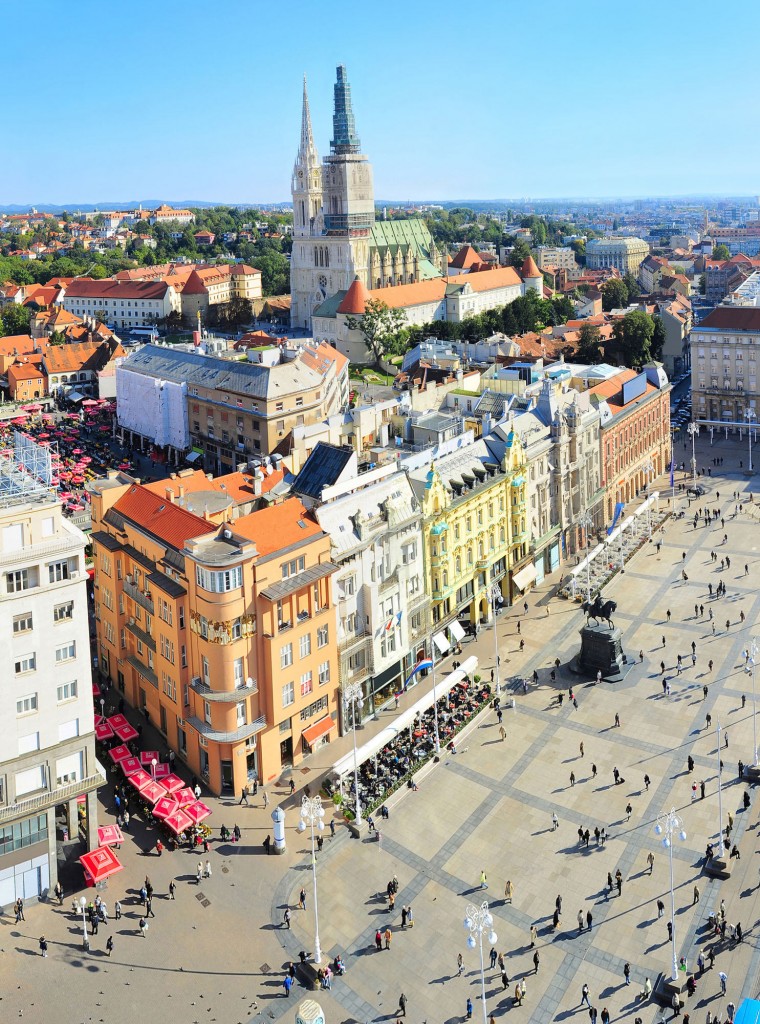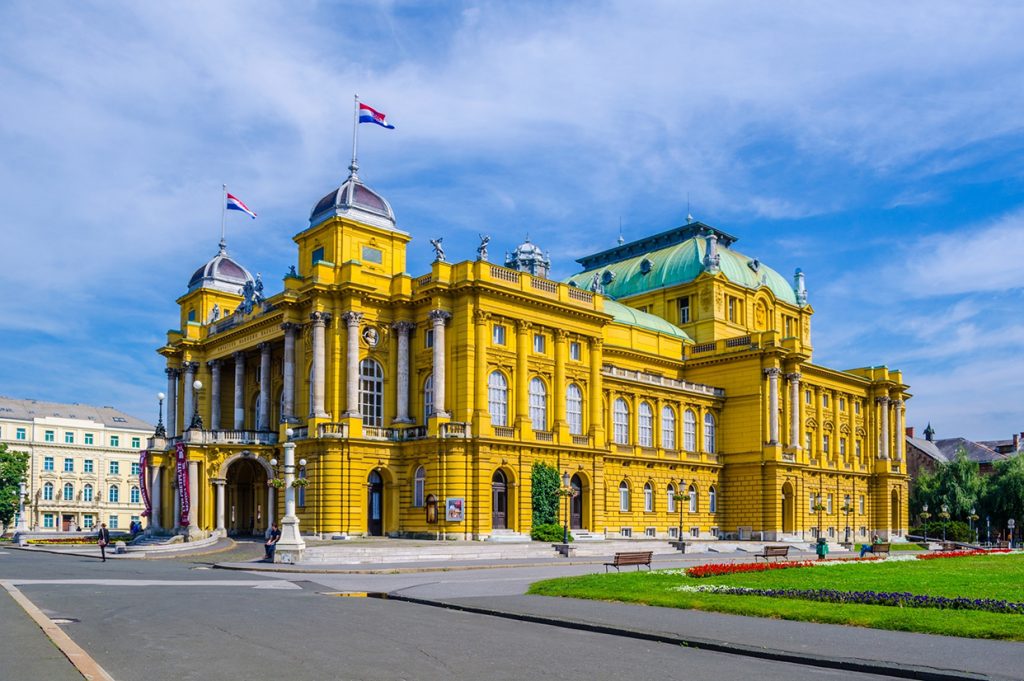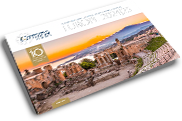The best things to do in Zagreb

As the capital of Croatia, Zagreb is well worth a detour from coast. Home to gorgeous churches, eclectic architecture, and bustling markets. It hosts a charming Old Town with winding streets and historic squares, and a Lower Town with fine museums, gardens, and a vibrant cafe scene.
Our short overview of Zagreb will leave you with the best things to do in the city. Add them to your Zagreb itinerary!
Upper Town

Ban Jelačić Square in Zagreb Old Town, Croatia
Zagreb’s Upper Town is the city’s charming historic core. Set atop a hill with beautiful cobblestoned streets. One of the ways to reach Old Town is through the world’s shortest funicular. Just 216 feet in length, it connects the Upper and Lower Towns.
Once in the Old Town, it is a pleasure to simply wander the streets. Enjoy the squares and historic buildings you encounter. A good place to start is the bustling Ban Jelačić Square, with its many sidewalk cafes. From here take a stroll down Tkalčićeva Street, the town’s main shopping area and full of restaurants and boutiques. Also have a look inside the Dolac Market. In the morning, farmers sell fresh produce along with meat, fish, and dairy products.
Look for the 11th century Zagreb Cathedral. It is the tallest building in Croatia, with its iconic twin spires that were built in 1880. Another famous church is the 13th century St. Mark’s. Its brightly tiled roof depicts the medieval coats of arms of Croatia, Dalmatia, Slavonia, and the city of Zagreb. The tiled roof was added in 1880. Inside there are statues by famed Croatian sculptor, Ivan Mestrovic.
Interesting parts of Zagreb’s medieval city fortifications include the 13th century Stone Gate – the last of the city’s five original gates. The Romanesque Lotrščak Tower, from the same period, with its red-tiled roof and whitewashed walls, served to guard the southern gate’s entrance to the Upper Town. Visitors can climb the tower for great views over the city.
Pay a visit to the Mestrovic Atelier Museum displays the sculptures of native Croatian artist Ivan Mestrovic. The museum is housed in his former home and studio. The City Museum in the 11th century Convent of St. Clair is located along the eastern town wall. It tells the long history of Zagreb across collections of art, documents, and archaeological and historical pieces.
Lower Town

Croatian National Theater of Zagreb, Croatia
Zagreb’s Lower Town is the more modern addition to the city. Here you can find a collection of great art museums and such cultural institutions as the Croatian National Theatre. The best-known collection is the Mimara Museum. It is housed in a 19th century palace and features works by a wide range of European masters like Rubens, Goya, Canaletto, Monet, and Degas.
Additional stellar museums in Lower Town include the Museum of Contemporary Art, the Art Pavilion, the Modern Gallery which focuses on Croatian artists, and the Croatian Museum of Naïve Art. Another noteworthy collection is held by the Archaeological Museum, which contains wide-ranging exhibits including such pieces as an Etruscan Mummy from the 3rd century B.C., and the Vučedol Dove, a ritual vessel dating back to at least 2500 BC.
The National Theatre was built in 1895 by Viennese architects. Its imposing yellow neo-Baroque facade is a Lower Town landmark. In addition to presenting ballet, drama and opera performances, the Theater boasts significant artwork including The Well of Life by Ivan Mestrovic in front of the building.
Zagreb’s Botanical Garden forms part of the so-called Green Horseshoe of parks around the Lower Town. The park features an arboretum, ponds, and ornamental bridges to create an inviting respite from the surrounding city.
A Day’s Outing to the Plešivica Wine Region

Plešivica wine region (Photo from Visit Zagreb Tourism board)
Located about an hour’s drive from Zagreb, the Plešivica Wine Region makes for a great day trip from the capital. Though this is the smallest of Croatia’s wine regions, it is the most successful and well known. The region produces a variety of wines, but the region’s soil facilitates production of sparkling wines, leading it to be called “Croatia’s Champagne Region”.
The Plešivička wine road connects a series of wineries where visitors can enjoy tastings and tours of the vineyards. Here you can discover indigenous grape varieties like Graševina and Ottonel used in producing local white wines and Portugizec for red wine. The annual Wine Days Festival in October is a must-do for visitors during the autumn harvest season.

